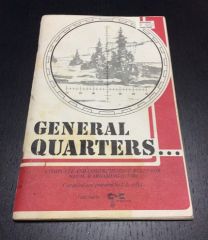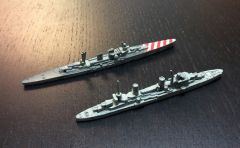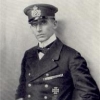I was up to Albany NY this past weekend to visit my son before their hellish winter weather sets in (overnight temps were already dipping into the low-thirties). While there we dug through some stuff I brought up to him, most of which came out of either the collection of a dear friend that passed away earlier this year, another friend who is culling the empire a bit, or from my own piles which have taken a bit of a winnowing of late. Always a fan/collector of rulesets, anything that might be interesting we send his way. This serves two great purposes: (1) it gives him plenty to do on those long cold Upstate evenings, and (2) he can master the rules and then teach us old codgers the finer points. Near the bottom of one of the boxes we found a surprise…a copy of General Quarters Rev 1.0.

This copy, most likely purchased second-hand in the last century, is tagged as having originated from the brilliant, still extant (as far as I know) Boardwalk Hobby Shop in Cincinnati OH. Never been there but I hear it’s quite a place. Sadly nothing remotely similar lies within striking distance for me, but it’s good to know places such as Boardwalk have not all gone to vapor.
We gave Mr. Gill’s first iteration a brief read-through and decided to give it a play, mostly just to understand and appreciate the evolution to the current rev. As to be expected they are exponentially briefer and abstract, yet play remarkably similarly, and the intent of allowing manageable multi-ship actions to be played to a historical-feeling result without having to resort to rivet-counting is successfully evident.
We decided on a brief one-on-one action using a couple of ships from a box of old Axis and Allies/War at Sea figures - HMAS Sydney versus Giuseppe Garibaldi, two light cruisers, the Med, July 1940.

In this sliver of the action which became known overall as the Battle of Calabria, the Royal Navy made a decent effort to intercept an Italian convoy bound for Benghazi, Libya. Vice-Admiral John Tovey’s Force A (comprised of five light cruisers and a single destroyer) formed the vanguard for Admiral Cunningham’s Force B, the main body (comprised of BB Warspite, CV Eagle and four destroyers) with Vice-Admiral Pridham-Wippell’s Force C bringing up the rear (BB’s Royal Sovereign and Malaya with ten destroyers).
The convoy was directly escorted by two light cruisers, eight destroyers and a pair of torpedo boats. The Italians, hoping to bait the RN into a slugfest, also dispatched Campioni’s 1st Fleet (two battleships, six light cruisers and seventeen destroyers) and Paladini’s 2nd fleet (six heavy cruisers, four light cruisers and twelve destroyers).
At approximately 1510, July 9, 1940, Tovey’s light cruisers ran headlong into Campioni’s force and immediately came under heavy fire. Quickly realizing the superiority of the Italians, Tovey attempted to disengage and withdraw. HMS Neptune was struck by fire from Giuseppe Garibaldi resulting in light damage.
Scenario
HMAS Sydney, following HMS Neptune in column, observes the latter straddled by fire from Garabaldi with some damage and moves to cover Neptune’s withdrawal. Within a few minutes Sydney and Garabaldi find themselves alone on a roughly parallel southerly course at a range of 18,500 yards.
The action will be just ten turns, one scale hour.
After-Action Report
A brief run-down of the action:
1524 – Confident of Neptune’s escape to the west, Sydney’s commander Captain John Collins orders his cruiser to open on Garabaldi, his broadside of eight six-inchers yielding a hit and minor hull damage at long range. Garabaldi’s commander Stanislao Caraciotti orders return fire (ten six-inch) but misses long, passing overhead.
1530 – Sydney, continuing ahead at 25 knots, fires again but misses. Caraciotti’s second salvo straddles Sydney which momentarily disappears behind a cloud of spray to emerge unscathed.
1536 – Collins orders a slight course change to the southeast aiming to converge on the Italian while maintaining his broadside. With the range continuing to shorten, Collins’ and Caraciotti’s next salvos miss.
1542 – The range is now down to 11,500 yards. Collin’s continues his fire on Garabaldi but misses astern. Garabaldi returns fire and again straddles Sydney yielding no damage. Garabaldi shows no sign of relenting, uncharacteristic for the Italian navy.
1548 – Rapidly closing, just 8,250 yards now separates Sydney and Garabaldi. Collins, maintaining his speed of 25 knots, fires yet another broadside, observing hits on Garabaldi’s forecastle (a gunnery hit). Caraciotti’s return main and secondary fire all miss. Collins remains wary despite the Italians abysmal gunnery.
1554 – Collins orders a second course change, turning slightly to the south. Sydney fires yet again yielding a second gunnery hit together with a hull hit on Garabaldi’s stern with damage to the Italian’s rudder. Making turns will now lengthen considerably for Caraciotti’s cruiser. Garabaldi lands a gunnery half-hit with her damaged main battery but misses again with her secondaries.
1600 - At 7,500 yards Sydney continues firing her main battery and misses. Collins orders his bank of torpedoes loosed to port with the expectation that the Italian will continue on a converging course. No sooner is the order given then Garabaldi’s next salvo slams into Sydney penetrating to and destroying her fire-control center and flooding a number of compartments. Sydney’s speed drops to 22-1/2 knots. Meanwhile Garabaldi’s 3.9-inch secondaries rake the British light cruiser but inflict no penetrating damage. Caraciotti orders his torpedoes into the water and a turn to the east.
1606 – Collins continues on his southerly course expecting the same of the Italian, but Garabaldi instead turns away to the east. Sydney’s gunfire misses and all of Collins' torpedoes pass safely off Garabaldi’s starboard quarter. Caraciotti, firing only his stern turrets manages yet another 1/2-hullbox hit on Sydney whose speed now drops to 15 knots. The Italian’s torpedoes miss, passing ahead of and behind the British cruiser.
1612 – Caraciotti continues his broad turn coming around to a northwestward heading. Once again in position to fire what remains of his broadside the Italian does so but misses. Collins, continuing on a southeasterly course, misses badly with his ninth salvo.
1618 – Collins and Sydney fire a final salvo scoring another ½-hull hit and a further gunnery hit. Garabaldi, down to a final turret, continues her turn to the west and delivers a parting shot, holing Sydney at the waterline yet again. As the distance between himself and Caraciotti lengthens Collins abandons any thought of pursuit.
Results
A look at the victory conditions gives a slight tip to Collins and Sydney, having largely wrecked the larger, better-armed and armored Garabaldi. Caraciotti, his decks littered with smashed guns, splinters and torn up decking while struggling with numerous flooded compartments, limps off hoping to find cover with Campioni’s main body. Mercifully there's no provision for fires in GQ 1.0 (unless we misread).
While Sydney’s main is largely intact, she too has severe flooding and her speed is sharply reduced. The Australians have, however, vanquished their foe and slip off to the west for a spell in the yard at Malta and some hasty repairs.
Given there were only two ships in the engagement, the game played out in just fifty-odd minutes (slightly less than the single scale hour).
GQ 1.0 game mechanics are blissfully simple. Ships carry attack strength (main and secondary) and defense strength factors with gunnery boiled down to a roll of three d6's - one to determine whether a hit has been achieved, one to determine topside damage (gunnery) and one to determine below-deck damage (hull). A further single die roll may be necessitated for critical hits. Distances are gauged in inches (took a bit of getting used to) with an inch representing 250 yards. A simplified turn gauge is provided, as is a torpedo gauge. Damage-control is extremely limited in scope. The game is bloody and rapidly cumulative.
A fun exercise, we acquired some insight into where GQ is today and how it got there versus where it began over forty years ago.
Wow, can it really have been forty years? How did I get so freakin' old? I need to add a road-trip to Cincinnati to the bucket list...
Healey










